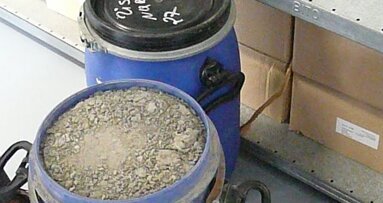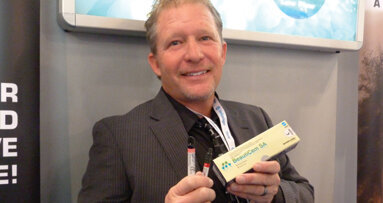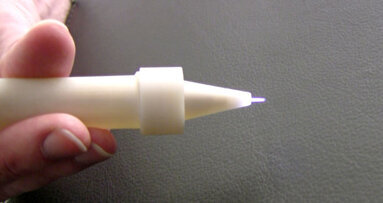Pittsburgh, PA, USA: Researchers at the University of Pittsburgh have developed a quick and simple method for detecting mercury in fish and dental samples, two substances at the centre of public concern about mercury contamination.
The technique involves a fluorescent substance that glows bright green when it is exposed to oxidised mercury, the researchers report in the current online edition of the Journal of the American Chemical Society. The intensity of the glow indicates the amount of mercury present.
Developed in the laboratory of Kazunori Koide, a chemistry professor in Pitt’s School of Arts and Sciences, the new method can be used on-site, and can detect mercury in 30 to 60 minutes for dental fillings (or amalgams) and 10 to 30 minutes for fish, Koide explained. “Our method could be used in the fish market or the dentist office,” he said. “We have developed a reliable indicator for mercury that a person could easily and safely use at home.”
The fluorescence results from the reaction of mercury ions with hydrocarbons called alkynes; the alkyne is converted into a ketone, which then creates a fluorescent molecule. Koide’s method differs from similar mercury indicators in that it withstands the oxidation process mercury samples must undergo prior to testing, Koide said.
The mercury species found in most fish and dental amalgams, such as the toxic methylmercury, must be converted into a safer variety of mercury with an oxidising agent. Other fluorescent detectors are often not compatible with samples that have been oxidised.
In testing fish, Koide and his team oxidised a piece of salmon (about the size of a fingertip) in water mixed with a chlorine solution similar to household bleach. The conversion process is safe and relatively simple, Koide said. Afterwards, the team added the alkyne solution, and the mixture glowed bright green.
The Pitt researchers also tested for mercury leaching from dental amalgam, a common tooth filling composed primarily of mercury mixed with smaller amounts of other metals. Concern exists about the mercury seeping from a filling into a person’s body and the disposal of unused amalgam by dentist offices—which is not federally regulated in the United States.
To test for leaching, the team pressed a cloth to a tooth with an amalgam filling for one minute; the sample glowed when exposed to the mercury-detecting agent. They also submerged two amalgam-filled teeth in the amino acid cysteine, to mimic sulphur-rich foods, which are thought to increase mercury seepage from amalgam. Again, the cysteine solution turned bright green when the indicator was added, suggesting that Koide’s method can also be used to monitor mercury leaching caused by sulphur-rich food.
In terms of amalgam disposal, Koide suggested that his method could be used to test dentist office waste water for mercury content on-site, without sending samples to analytical laboratories.
WASHINGTON, DC, USA: The US Food and Drug Administration said silver-coloured dental fillings that contain mercury are safe for patients, reversing an ...
NEW YORK, N.Y., USA: Jack D. Griffin, DMD, has been using Shofu Dental Co. products in his St. Louis-area dental practice for more than 20 years, initially ...
COLUMBIA, Mo., USA: Engineers at the University of Missouri and their research collaborators at Nanova, a corporation that designs, patents and sells ...
NEW YORK, USA/LEIPZIG, Germany: Medical and dental problems associated with mouth breathing often go unnoticed by health professionals, a new ...
Running a dental practice is a multifaceted endeavour that requires not only excellent clinical knowledge but also a solid understanding of business. In ...
LAKELAND, Fla., US: Although an increasing number of dentists and patients are choosing resin composites as restorative materials, amalgam is still widely ...
WASHINGTON, D.C., Wash., USA: New research could revitalize the discussion about the use of amalgam fillings. According to a new study released by a broad ...
Bias is an intrinsic aspect of human cognition, and healthcare professionals—including those in dentistry—are not immune to its influence. Understanding...
NEW YORK, N.Y., USA: A dental student at the University of North Carolina School of Dentistry was killed along with his wife and his wife’s sister at ...
SANTA BARBARA, CA, USA: A unique dental program in Afghanistan is saving lives, raising the infrastructure level and bringing about social change for women ...
Live webinar
Wed. 14 January 2026
12:00 PM EST (New York)
Dr. Théo Laplane, Dr. Robert Gottlander DDS
Live webinar
Fri. 16 January 2026
12:00 PM EST (New York)
Live webinar
Mon. 19 January 2026
1:00 PM EST (New York)
Philipp Kopp, Michael Seeber
Live webinar
Thu. 22 January 2026
9:00 AM EST (New York)
Prof. Judith Jones D.D.S; M.P.H., Prof. Kakuhiro Fukai D.D.S., Ph.D, Dr. Bathsheba (Bethy) Turton
Live webinar
Thu. 22 January 2026
2:00 PM EST (New York)
Dr. Nicola M. Grande DDS, PhD
Live webinar
Wed. 28 January 2026
8:00 AM EST (New York)
Live webinar
Wed. 28 January 2026
11:00 AM EST (New York)
Prof. Dr. Jan-Frederik Güth



 Austria / Österreich
Austria / Österreich
 Bosnia and Herzegovina / Босна и Херцеговина
Bosnia and Herzegovina / Босна и Херцеговина
 Bulgaria / България
Bulgaria / България
 Croatia / Hrvatska
Croatia / Hrvatska
 Czech Republic & Slovakia / Česká republika & Slovensko
Czech Republic & Slovakia / Česká republika & Slovensko
 France / France
France / France
 Germany / Deutschland
Germany / Deutschland
 Greece / ΕΛΛΑΔΑ
Greece / ΕΛΛΑΔΑ
 Hungary / Hungary
Hungary / Hungary
 Italy / Italia
Italy / Italia
 Netherlands / Nederland
Netherlands / Nederland
 Nordic / Nordic
Nordic / Nordic
 Poland / Polska
Poland / Polska
 Portugal / Portugal
Portugal / Portugal
 Romania & Moldova / România & Moldova
Romania & Moldova / România & Moldova
 Slovenia / Slovenija
Slovenia / Slovenija
 Serbia & Montenegro / Србија и Црна Гора
Serbia & Montenegro / Србија и Црна Гора
 Spain / España
Spain / España
 Switzerland / Schweiz
Switzerland / Schweiz
 Turkey / Türkiye
Turkey / Türkiye
 UK & Ireland / UK & Ireland
UK & Ireland / UK & Ireland
 International / International
International / International
 Brazil / Brasil
Brazil / Brasil
 Canada / Canada
Canada / Canada
 Latin America / Latinoamérica
Latin America / Latinoamérica
 China / 中国
China / 中国
 India / भारत गणराज्य
India / भारत गणराज्य
 Pakistan / Pākistān
Pakistan / Pākistān
 Vietnam / Việt Nam
Vietnam / Việt Nam
 ASEAN / ASEAN
ASEAN / ASEAN
 Israel / מְדִינַת יִשְׂרָאֵל
Israel / מְדִינַת יִשְׂרָאֵל
 Algeria, Morocco & Tunisia / الجزائر والمغرب وتونس
Algeria, Morocco & Tunisia / الجزائر والمغرب وتونس
 Middle East / Middle East
Middle East / Middle East





























































To post a reply please login or register